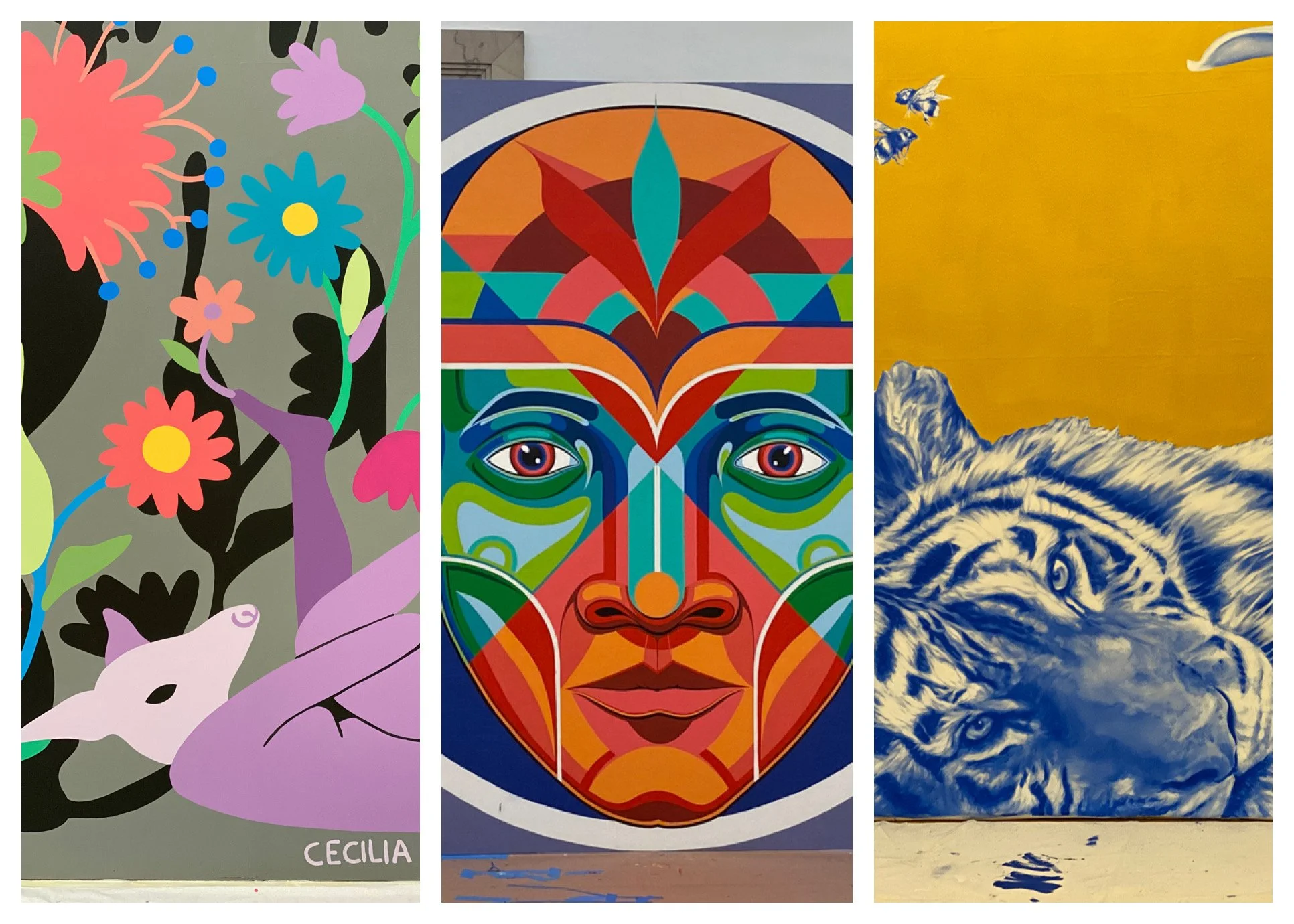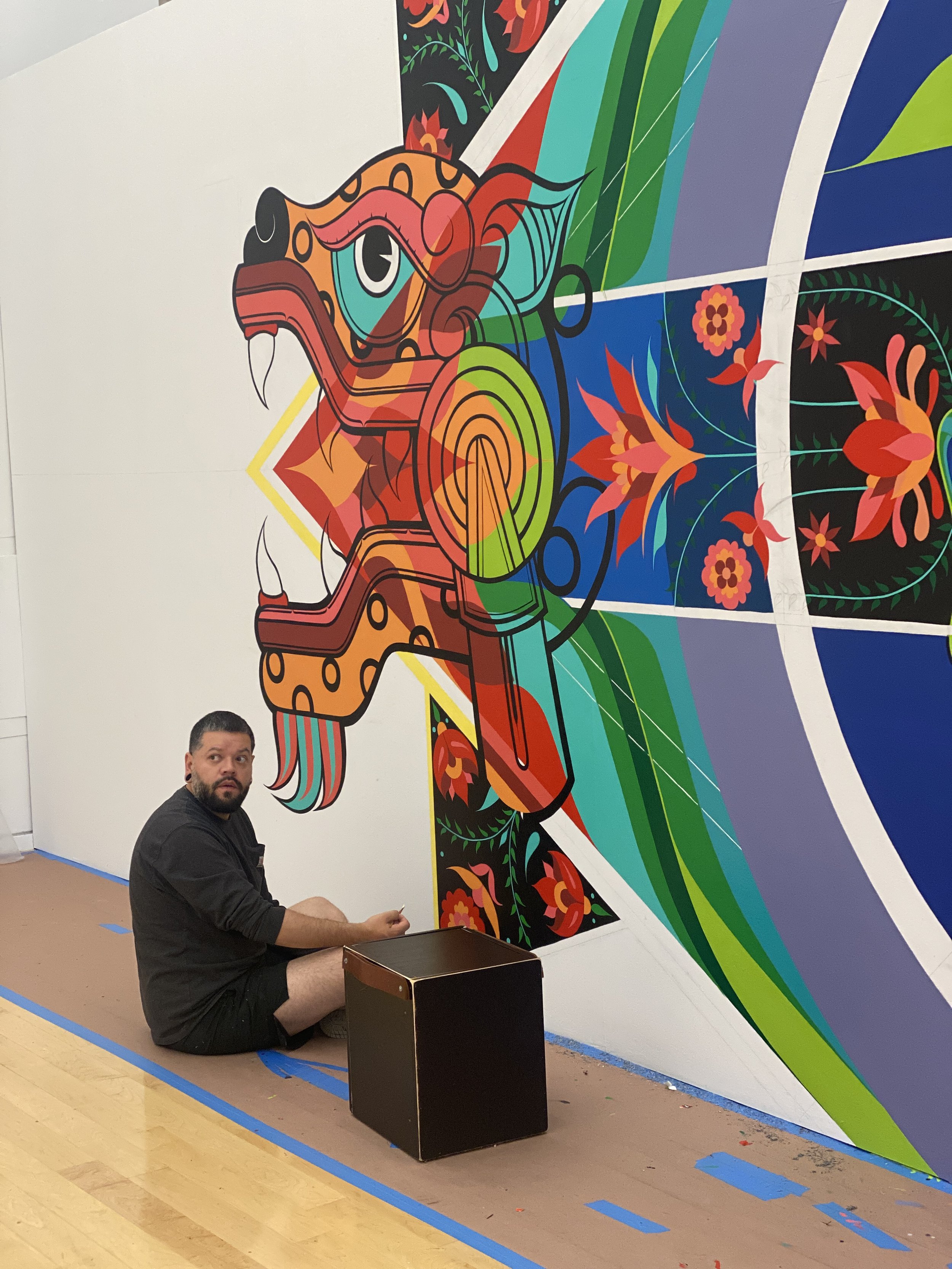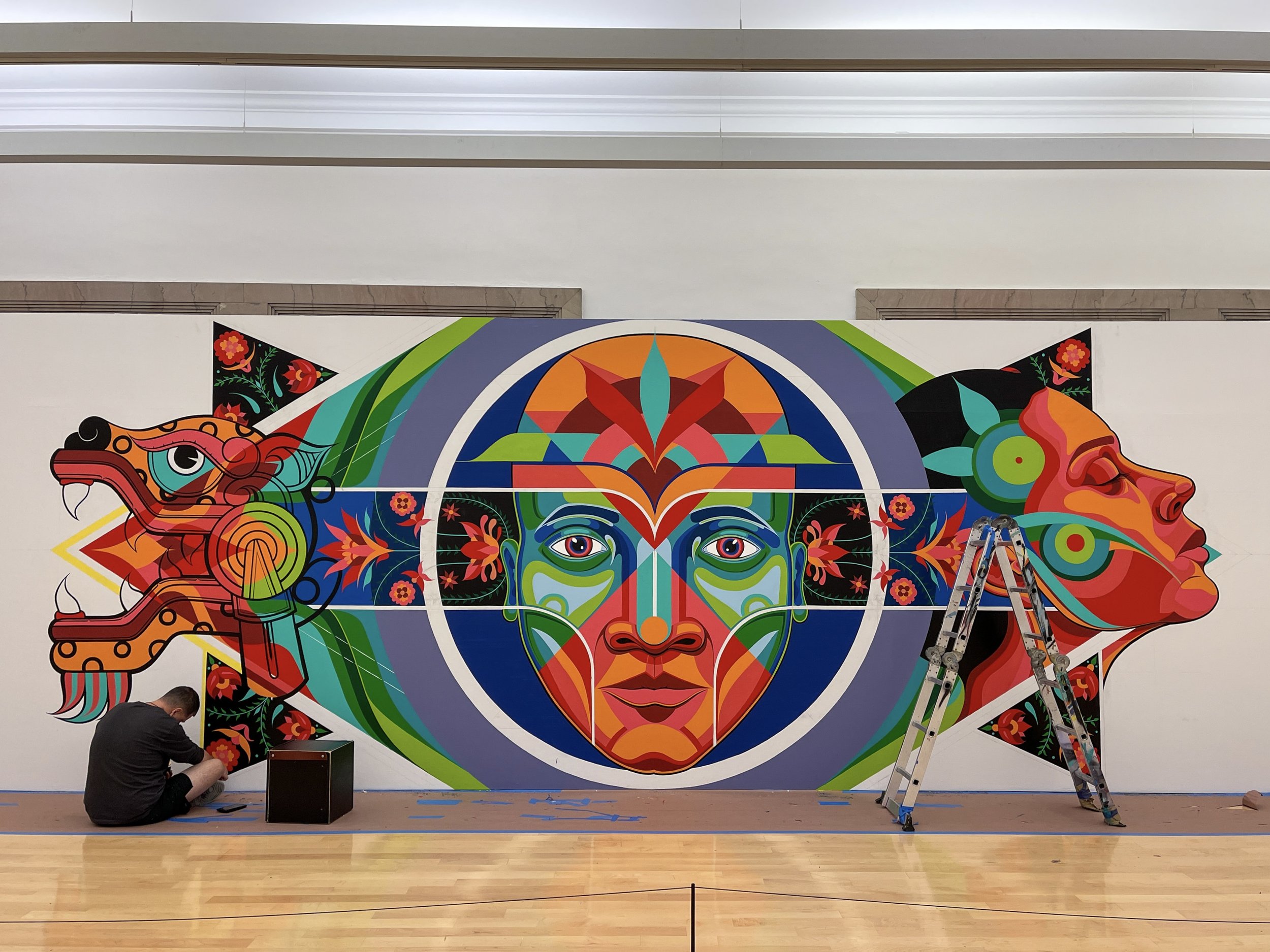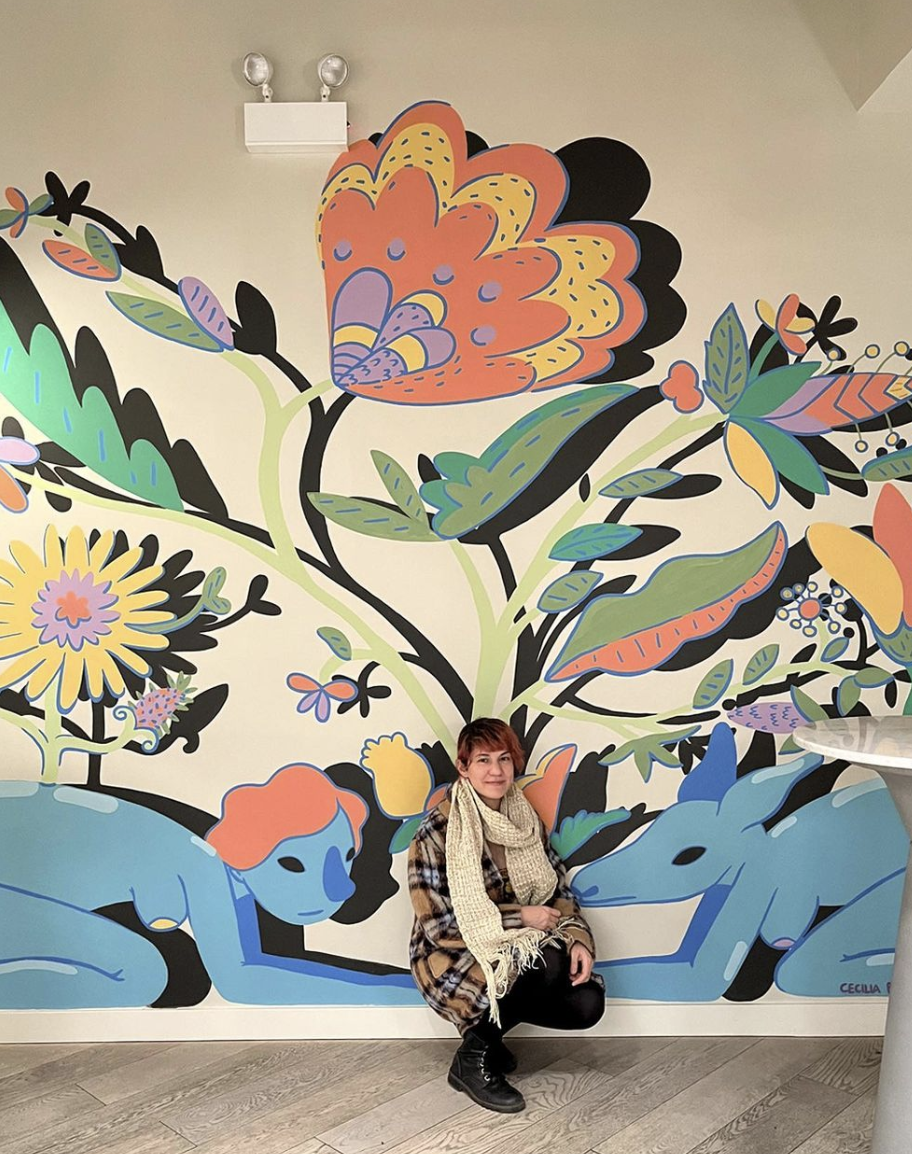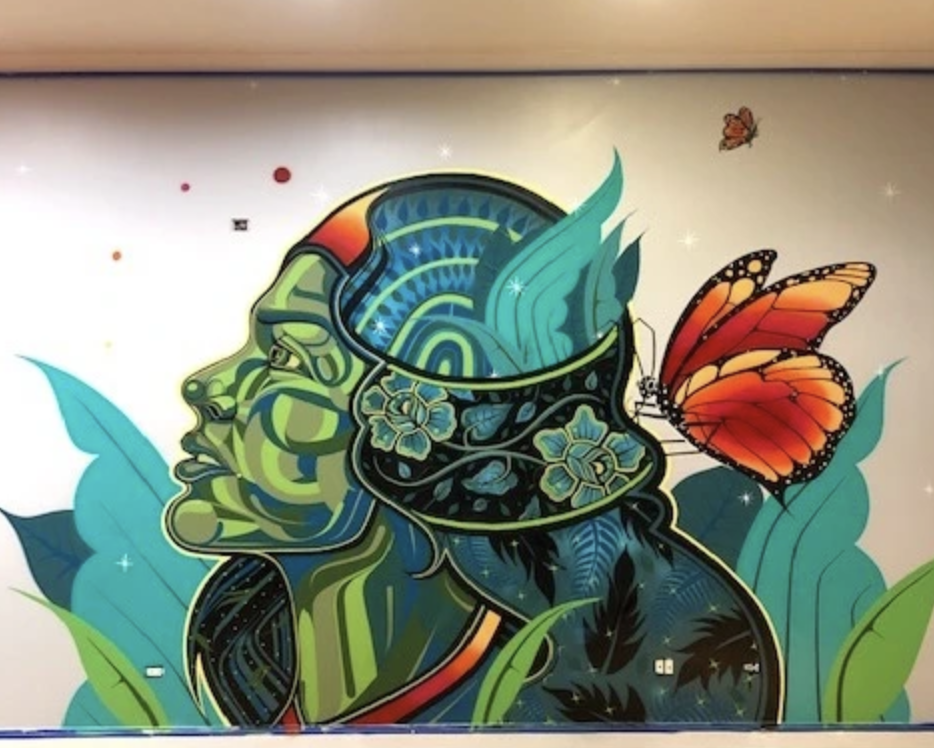How is a mural made? That was the idea behind a recent exhibit at the Chicago Cultural Center. We did a Q&A with each of the featured artists: Cecilia Beaven, Miguel A. Del Real and Anna Murphy.
Duke and I have always appreciated murals, but didn’t know a whole lot about what went into their creation. Are they gridded out? Are they done freehand? Do they use spray paint? Or are all these things, as I imagine, dependent upon the artist?
That’s why it was so cool to visit the Chicago Cultural Center and see Exquisite Canvas: Mural Takeover, an onsite installation sponsored by the Department of Cultural Affairs and featuring the talent of three local artists: Cecilia Beaven, Miguel A. Del Real and Anna Murphy. The experiential exhibit was held on the first floor galleries and invited visitors to meet the artists and watch their progress as they completed their works. (The exhibit ran from June 10, 2023 and closed on September 3).
Part of the idea behind Exquisite Canvas at the Chicago Cultural Center was to show the artists’ process of creating their murals.
Pro tip: In our opinion, you have a better chance of seeing an impressive art exhibit at the Cultural Center, which is free, versus the often disappointing and even laughable works displayed at the Museum of Contemporary Art.
The first room of the exhibit had a brightly colored geometric mural titled Perspectiva Perpetua by Miguel, who has a tattoo and calligraphy background. It depicted a man in the middle, staring intently ahead, with an Aztec jaguar on one side and a woman in profile with her eyes closed and her head tilted upwards on other other. Miguel was working on his mural the day we visited. It was pretty cool to have the opportunity to chat with him briefly.
Miguel A. Del Real working on Perspectiva Perpetua
We admired his mural as well as the other two by Cecilia and Anna. Cecilia’s piece, Moon Bloom, references tenangos, a colorful style of embroidery that originated in the Tenango de Doria municipality in the Mexican state of Hidalgo.
Moon Bloom by Cecilia Beaven
Anna’s concept, Awakening, featured a resting tiger, symbolizing the inner strength in each of us. She’s known for her photorealistic style and use of blue and gold paint.
Awakening by Anna Murphy
Seeing Miguel at work gave us a glimpse into the making of a mural, but we still had a lot of questions. So we decided to reach out to the artists to learn more.
Fortunately, all three took the time to answer our questions, and their Q&As provided a fascinating glimpse into their creative process. –Wally
Cecilia Beaven
How did you get into art?
I remember drawing since I remember being myself. Creating images has always been an activity that fascinates me and it’s my favorite form of communication or expression. I started taking art classes when I was a kid, and I started doing art more professionally right after highschool when I went to art college.
How do you get your ideas for murals? What subjects do you cover?
I explore mythology through a very playful lens that allows for experimentation and speculation. I draw from Aztec and other Mesoamerican stories and combine their archetypal elements with fiction in a seamless way. I also include a self-representative character that inhabits these narratives and allows for reflection on my place in the making of culture and participation in it.
Which character is that?
The character that represents me is the woman figure with a big nose and short hair that you can see in a lot of my pieces.
Are they entirely planned out in advance?
They usually are. I do lots of sketches, color tests, and planning ahead of time, so when I’m on site creating a mural I know what steps to follow. There are a few decisions that get modified once I’m in front of the actual wall, but not many.
Do you draw them out on the wall?
Yes. The sketching technique depends on the project, resources available, and time limitations. Sometimes I work traditionally and follow a grid, sometimes I project my sketch, and sometimes I just freehand recreate my sketch.
Tell us more about your technique and the process of creating your murals.
I create a loose sketch on a sketchbook using non-photo blue pencil. Once I like where it's going, I ink it. Then I scan my drawing and get rid of the blue. I use photoshop to do color tests and once I’m happy with the color palette, I print it. I then mix paints that match my tones.
On the mural site, I recreate my sketch on the wall (using a grid, freehand, or with a projector, depending on the project) and then start to apply my colors from the background to the foreground.
How long does it typically take to create a mural?
The time depends on the size of the wall and how detailed it is. But I work pretty fast, so I’ve completed small murals in one day and the largest ones in two or three weeks.
How would you describe your style?
Playful, cartoony, absurd, mythological, self-reflective, bold.
What’s your favorite part about creating a mural?
I love using my whole body to create an image, to see something as big as me, or bigger, take shape as I move my body. I also love being on ladders, scaffoldings, and lifts. And I enjoy the mindset that creating a mural puts me in, I feel calm and focused.
What is your least favorite part?
Painting the lower part of the walls that require bending, kneeling or even lying down on the floor.
What message do you want people to get from your murals?
Ideally, I want people to experience happiness and a sense of hope.
Instagram: @samuraiceci
Miguel A. Del Real
How did you get into art?
It wasn’t until second or third grade. I was trying to replicate the Ninja Turtles, and I think that’s what really got me into drawing. And then around seventh or eighth grade and throughout high school, I got into doing graffiti letters.
I stopped for a little bit when I went to Northern Illinois University, but then I came back into the city and started hanging out with old friends. And I started getting back into the arts, like with graffiti murals.
I would say that’s what helped develop me as an artist, those years doing experimental work — that’s what led me to be taken a little bit more seriously as a professional artist.
How do you get your ideas for murals? What subjects do you cover?
That’s tough. You do want to be respectful to where you’re painting, And I feel like that approach is what has helped shape some of the ideas or concepts.
These past couple years, I’ve been experimenting more with the sense of consciousness. I don’t want to say spirituality or anything like that. But it’s just been more like depicting dreams, combining some abstract elements with figurative elements, patterns, heavy line work.
Are they entirely planned out in advance?
I like to leave some breathing room. So I would say, when it’s a job that really requires that they’re more hands-on, they want everything planned out.
This particular one that the cultural center, they allowed a lot of flexibility, where I just gave them a rough sketch. And then out of that, I was able to change it and add things as I went, inspired by the space.
Do you draw them out on the wall? Tell us about your technique and the process of creating your murals.
I just start sketching. Like at the cultural center, I sketched it with pencil. They wanted it with a brush — I couldn’t use any aerosol. Then you start blocking out sections with paint and color, and then you move on to details.
When it’s a mural outside, I can use spray paint and I start sketching with the paint itself, just blocking in shapes.
How long does it typically take to create a mural?
As fast as two and a half weeks to a month and a half.
How would you describe your style?
With my background in graffiti lettering, I use the chisel qualities of a brush, from thick to thin, combined with sacred geometry with shapes like circles, squares, triangles.
What’s your favorite part about creating a mural?
It’s definitely the painting. Once you have the sketch done, the coloring of it — even though that’s where I struggle the most, where I go back and forth with colors. This is when it really starts coming to life.
What is your least favorite part?
The sketching, because everything needs to be locked in precisely. So if something looks wrong, then that throws off the whole mural — everything needs to be mathematically divided.
What message do you want people to get from your murals?
The common theme that I have, regardless of the different institutions and corporations that I’ve painted for, it’s always the message of transformation, evolving. Man fusing with spirit or nature.
Instagram: @delrealink
Anna Murphy
How did you get into art?
I received a BFA in painting from the University of Louisville in 2011. After many years creating fine art oil paintings on canvas, I painted my first mural in 2018, and fell in love with the large scale and community aspect of public art.
How do you get your ideas for murals? What subjects do you cover?
The central themes of my work include celebrating nature’s wondrous beauty and the divine connection we share with one another, Mother Earth and the animal kingdom. My spirituality is the driving force of my life and my art.
Are they entirely planned out in advance? Do you draw them out on the wall?
Yes, I design the layout in PhotoShop, then project a line drawing of my design onto the wall. With a small paintbrush, I paint the outline of the design onto the wall.
How would you describe your style?
With a traditional painting background, I merge the worlds of fine art and street art by bringing an emphasis on intricate detail into my large-scale public murals.
Tell us about your technique and the process of creating your murals.
Hand-painted with brushes, my painting style uses a process similar to watercolor, building up thin layers of washes to create depth, texture and a lifelike quality.
What’s your favorite part about creating a mural?
Knowing that it will bring joy and inspiration to those who see it, for years to come.
What is your least favorite part?
Spiders.
What message do you want people to get from your murals?
The metallic gold background reflects our own divinity and the sacredness of life. The cobalt blue, a symbol of Earth, like Heaven and Earth together, this combination portrays the connection between the human and the divine. The cherubs are also a symbol of our connection to the divine, and guardians of our pure and spiritual nature. The bees act as a symbol of a higher frequency, community and a connection to all things. The flowers and plants, a symbol of Mother Nature’s beauty, represent a paradise that can also be found within.
Instagram: @annapmurphy
Chicago Cultural Center
78 East Washington Street
Chicago, Illinois
USA
